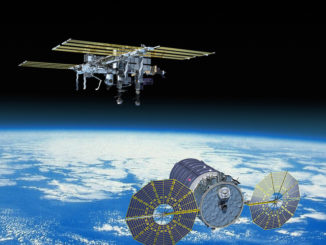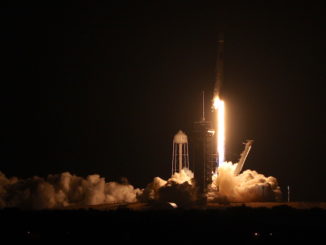
NASA officials said Tuesday the weekend test-firing of the Space Launch System moon rocket’s core stage was cut short by an out-of-limits parameter in a hydraulic system for gimbaling, or vectoring, one of its engines.
NASA Administrator Jim Bridenstine said engineers are “feeling pretty good” about the data gathered during the shortened test-firing, and managers may decide to ship the SLS core stage to the Kennedy Space Center for launch preparations without re-attempting the planned eight-minute hot fire.
“We are still kind of in a position where may not have to do another hot fire,” Bridenstine told Spaceflight Now in an interview Monday. “We might be able to take the rocket down to Kennedy and get it ready for launch. That decision has not been made. We don’t know.”
If NASA officials opt to conclude testing of the SLS core stage at Stennis and ship it by barge to Kennedy, it might preserve a chance to launch the first SLS test flight before the end of the year. The schedule was already tight before the hot fire test Saturday, but program managers said last week there was a path to launching the SLS test flight this year.
The Space Launch System is a major piece of NASA’s Artemis program, which aims to return astronauts to the moon for the first time since 1972.
The SLS will launch NASA’s Orion crew capsule to send astronauts to the vicinity of the moon. NASA plans to construct a mini-space station to serve as a research outpost and waypoint for crews traveling between Earth and the lunar surface. The Orion spacecraft will link up with a descent craft in lunar orbit, where astronauts will float into the lander to head for the moon’s surface.
The first test flight of the SLS, known as Artemis 1, will send an unpiloted Orion crew capsule into lunar orbit on a mission lasting several weeks. The Orion spacecraft will come back to Earth for a splashdown in the Pacific Ocean, setting the stage for the first crewed SLS/Orion mission to the moon around 2023.
“The question is did we get enough data from what we just did to make people comfortable that we can go forward with the launch,” Bridenstine said. “Remember, the first launch is uncrewed, so we can accept some risk here that we wouldn’t normally accept.
“But we also have to remember that if something goes wrong, it sets us back significantly,” he said. “There are a lot of decisions in front of us.”
Wayne Hale, a former space shuttle program manager and current member of the NASA Advisory Council, tweeted he believes teams should proceed with a second hot fire test.
“Getting some more data on last weekend’s SLS hotfire test,” Hale wrote Tuesday. “Limits were set to conservatively protect hardware and cut the test off early. No damage to core stage or engines. My advice would be to retest and get complete data – may be a couple of weeks but schedule is secondary.”

The parameter in the core stage hydraulic system that triggered the early engine shutdown Saturday used “intentionally conservative” settings that were specific to the test-firing on the B-2 test stand at NASA’s Stennis Space Center in southern Mississippi, the space agency said in a statement Tuesday.
The hot fire ended 67.2 seconds after the core stage’s four Aerojet Rocketdyne RS-25 engines fired on the test stand. The engines throttled up to full power — 109% of rated thrust — and generated 1.6 million pounds of thrust.
Test engineers ran the 212-foot-tall (65-meter) rocket stage, built by Boeing, through a simulated countdown throughout the day Saturday, loading more than 700,000 gallons of super-cold liquid hydrogen and liquid oxygen into the orange rocket stage, pressuring the propellant tanks, and setting up the rocket for engine start.
Actuators in the engine thrust vector control system began gimbaling, or pivoting, the engines about a minute into the test-firing. The thrust vector control, or TVC, system is designed to steer the rocket in flight.
“During gimballing, the hydraulic system associated with the core stage’s power unit for Engine 2, also known as engine E2056, exceeded the pre-set test limits that had been established,” NASA said. “As they were programmed to do, the flight computers automatically ended the test.”
“That part of the (test) is very dynamic, and a lot of things are happening at the same time,” Bridenstine said. “When we started gimballing the engines, we gimbal with the hydraulic system … There was one measurement within the hydraulic system that got out of parameters, and that sent the signal to shut down all four engines. That parameter that was tested, that’s not a parameter that would even be measured on a flight. That was a test parameter that was being measured.”
The TVC system is driven by hydraulic pressure generated by Core Stage Auxiliary Power Units, or CAPUs. Two actuators pivot each engine.
“If this scenario occurred during a flight, the rocket would have continued to fly using the remaining CAPUs to power the thrust vector control systems for the engines,” NASA said.
“During the test, the functionality of shutting down one CAPU and transferring the power to the remaining CAPUs was successfully demonstrated,” NASA said. “This gimballing test event that resulted in shutting down the CAPU was an intentionally stressing case for the system that was intended to exercise the capabilities of the system. The data is being assessed as part of the process of finalizing the pre-set test limits prior to the next usage of the core stage.”

Early speculation on the cause of the premature end to the hot fire test focused on a major component failure, MCF, reading on Engine 4. NASA said Tuesday a sensor reading that indicated the MCF on Engine 4 was not related to the hot fire shutdown. The sensor reading involved the loss of “one leg redundancy” in the instrumentation for Engine 4 about 1.4 seconds after ignition, the agency said.
“Test constraints for hot fire were set up to allow the test to proceed with this condition, because the engine control system still has sufficient redundancy to ensure safe engine operation during the test,” NASA said. “The team plans to investigate and resolve the Engine 4 instrumentation issue before the next use of the core stage.”
John Honeycutt, NASA’s SLS program manager, also noted in a press conference Saturday night that engineers observed a flash around the thermal blanket around one of the engines.
“A visual inspection of the thermal blankets that protect the engine show signs of some exterior scorching, which was anticipated due to their proximity to engine and CAPU exhaust,” NASA said.
Data gathered during the test Saturday indicated normal temperatures in the core stage engine section throughout the firing.
“The engine section is in good shape,” Bridenstine said. “The core stage of the rocket, in general, is actually in good shape. The thermal blankets were scorched a little bit, but I’m being told that that’s not terribly unusual. They’re there for that purpose, to control the temperatures.”
Bridenstine’s nearly three-year tenure as head of NASA ends Wednesday with the start of the incoming Biden administration.
“They’re still looking through the data, but based on the preliminary feedback, I’m actually feeling good about it,” Bridenstine said.
The team can make slight adjustments to the thrust vector control parameters and prevent an automatic shut down if they decide to conduct another test with the core stage mounted in the B-2 stand.
NASA said officials will hold a media briefing later this week to discuss the latest updates on the SLS core stage testing.
Assuming NASA decides to attempt another full-duration core stage test-firing, officials said the test team can adjust parameters in the thrust vector control system to prevent an automatic shutdown.
If managers choose to end the SLS test campaign at Stennis, known as the Green Run, and send the core stage to Florida for launch preparations, Bridenstine said the rocket could be test-fired for a short duration on pad 39B at the spaceport.
“The challenge is, on the pad at Kennedy, you can test the ignition system and you can get the engines to fire, and things like that,” Bridenstine said. “But we have to remember that the hot fire test is testing the entire flight profile. That’s why we were throttling down the engines as you go through Max-Q (the period of flight where aerodynamic pressures are greatest). And then you throttle the engines back up, and then you start gimballing the engines in a significant way, and it’s all very dynamic.
“The reason to do the Green Run test, and the hot fire, is to get the data from all those very dynamic situations,” he said. “At the launch pad at Kennedy, we can’t really go through all of that. So there’s a difference between what we can do at the launch pad and what we can do at the test stand, a big difference.”
At Kennedy, ground crews will mate the core stage to two powerful side-mounted solid rocket boosters, and mount an upper stage and the Orion capsule on top of the launcher inside the Vehicle Assembly Building. The fully stacked SLS will stand 322 feet, or 98 meters, tall and will generate 8.8 million pounds of thrust at liftoff, more than the Apollo-era Saturn 5 moon rocket or the space shuttle.
John Shannon, Boeing’s SLS program manager, said before the test-firing teams wanted to get at least 250 seconds of run time on the core stage before moving on from the hot fire. By that point in the test, the engines would have throttled down and powered back up to full thrust and completed two gimbal profiles, including a sweep at about T+plus 2 minutes, 30 seconds, to check the structural response to the engine movements.
A full-duration test of more than eight minutes would have allowed engineers to collect even more data, including information on the functionality of the engine steering system when the propellant tanks are nearly empty.
“We have said all along that we would like to get to at least 250 seconds, but I think we need to do our due diligence and go look at the data we collected to ensure that we’ve got a good plan moving forward,” Honeycutt said Saturday.
NASA officials considered canceling the Green Run hot fire test at Stennis after Boeing suffered delays in building the core stage at the Michoud Assembly Facility in Louisiana. But the agency decided in 2019 to go ahead with the test-firing, citing safety and reliability benefits for future astronauts riding on the launcher on missions to the moon.
Email the author.
Follow Stephen Clark on Twitter: @StephenClark1.



